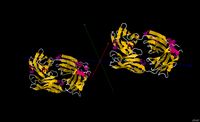
Photo from wikipedia
Abstract Aim Cetuximab and panitumumab are common antibodies against epidermal growth factor receptor (EGFR) that can be used in combination with chemotherapy for the treatment of metastatic colorectal cancer (mCRC).… Click to show full abstract
Abstract Aim Cetuximab and panitumumab are common antibodies against epidermal growth factor receptor (EGFR) that can be used in combination with chemotherapy for the treatment of metastatic colorectal cancer (mCRC). Although these two drugs are considered to be very similar, differences in the efficacy and safety of cetuximab and panitumumab are still unclear. We conducted this meta-analysis to explore the effects and adverse reactions of cetuximab and panitumumab in the treatment of mCRC. Methods We searched PubMed, the Cochrane Library, Embase, Web of Science, China national knowledge infrastructure (CNKI) and WanFang databases to identify records related to the efficacy and safety of cetuximab and panitumumab in the treatment of mCRC. The search terms were “cetuximab,” “panitumumab,” and “colorectal cancer.” The deadline of searching was April 2022. Review manager 5.4 software was used to perform the statistical analysis for this meta-analysis. Pooled hazard ratio (HR) with 95% confidence intervals (CI) were calculated to evaluate the overall survival (OS) and progression free survival (PFS) of cetuximab and panitumumab in the treatment of mCRC. Results There was no significant difference in OS, PFS, and response rate (RR) between cetuximab arm and panitumumab arm (OS: HR = 0.91, 95% CI = 0.81–1.03, p = .14; PFS: HR = 0.92, 95% CI = 0.83–1.02, p = .11; RR: OR = 1.22, 95% CI = 0.96–1.61, p = .14). We also did not observe any statistical difference between both arms in incidence of acneiform rash, severe acneiform rash, diarrhea, and severe diarrhea (acneiform rash: OR = 1.09, 95% CI = 0.84–1.42, p = .51; severe acneiform rash: OR = 1.50, 95% CI = 0.80–2.81, p = .21; diarrhea: OR = 1.08, 95% CI = 0.82–1.42, p = .58; severe diarrhea: OR = 0.90, 95% CI = 0.44–1.84, p = .77). The incidence of paronychia was decreased in the panitumumab arm, but that of hypomagnesemia and severe hypomagnesemia were decreased in the cetuximab arm. (paronychia: OR = 0.74, 95% CI = 0.55–1.00, p = .05; hypomagnesemia: OR = 1.85, 95% CI =1.41–2.41, p < .00001; severe hypomagnesemia: OR = 2.66, 95% CI = 1.52–4.67, p = .0006). Conclusion There was no significant difference in OS, PFS and RR between the cetuximab arm and panitumumab arm in the treatment of mCRC. For adverse reactions, the incidence of paronychia was decreased in the panitumumab arm, and the incidence of hypomagnesemia was deceased in the cetuximab arm.
Journal Title: Immunopharmacology and Immunotoxicology
Year Published: 2022
Link to full text (if available)
Share on Social Media: Sign Up to like & get
recommendations!